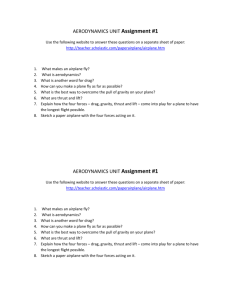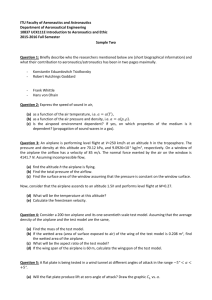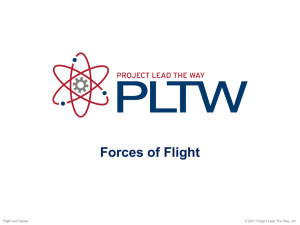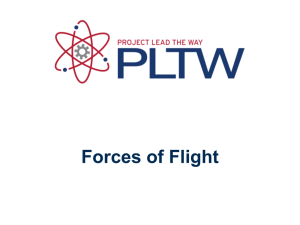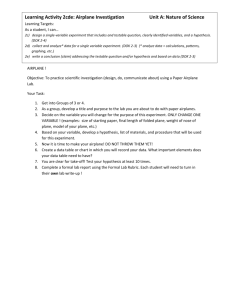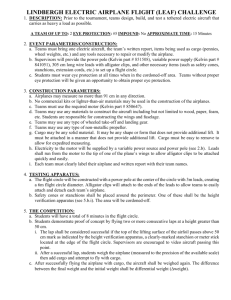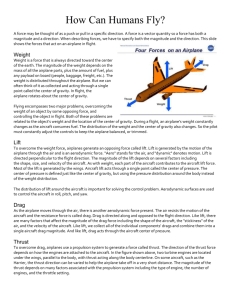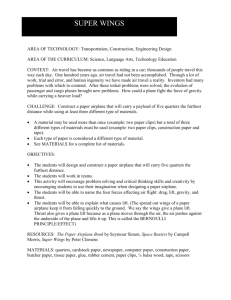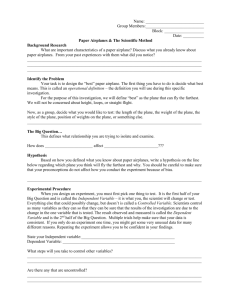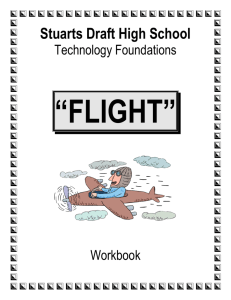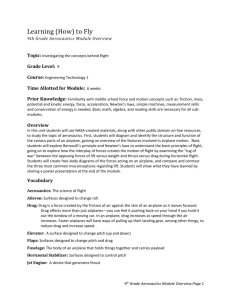Flight Dynamics 9-12
advertisement
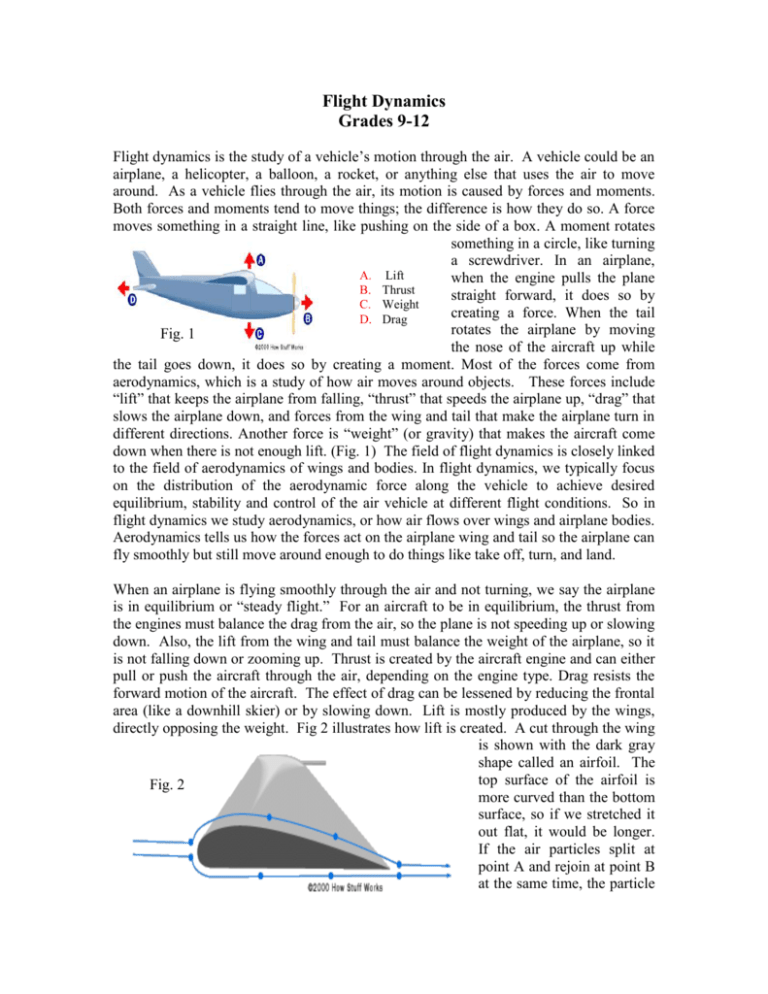
Flight Dynamics Grades 9-12 Flight dynamics is the study of a vehicle’s motion through the air. A vehicle could be an airplane, a helicopter, a balloon, a rocket, or anything else that uses the air to move around. As a vehicle flies through the air, its motion is caused by forces and moments. Both forces and moments tend to move things; the difference is how they do so. A force moves something in a straight line, like pushing on the side of a box. A moment rotates something in a circle, like turning a screwdriver. In an airplane, A. Lift when the engine pulls the plane B. Thrust straight forward, it does so by C. Weight creating a force. When the tail D. Drag rotates the airplane by moving Fig. 1 the nose of the aircraft up while the tail goes down, it does so by creating a moment. Most of the forces come from aerodynamics, which is a study of how air moves around objects. These forces include “lift” that keeps the airplane from falling, “thrust” that speeds the airplane up, “drag” that slows the airplane down, and forces from the wing and tail that make the airplane turn in different directions. Another force is “weight” (or gravity) that makes the aircraft come down when there is not enough lift. (Fig. 1) The field of flight dynamics is closely linked to the field of aerodynamics of wings and bodies. In flight dynamics, we typically focus on the distribution of the aerodynamic force along the vehicle to achieve desired equilibrium, stability and control of the air vehicle at different flight conditions. So in flight dynamics we study aerodynamics, or how air flows over wings and airplane bodies. Aerodynamics tells us how the forces act on the airplane wing and tail so the airplane can fly smoothly but still move around enough to do things like take off, turn, and land. When an airplane is flying smoothly through the air and not turning, we say the airplane is in equilibrium or “steady flight.” For an aircraft to be in equilibrium, the thrust from the engines must balance the drag from the air, so the plane is not speeding up or slowing down. Also, the lift from the wing and tail must balance the weight of the airplane, so it is not falling down or zooming up. Thrust is created by the aircraft engine and can either pull or push the aircraft through the air, depending on the engine type. Drag resists the forward motion of the aircraft. The effect of drag can be lessened by reducing the frontal area (like a downhill skier) or by slowing down. Lift is mostly produced by the wings, directly opposing the weight. Fig 2 illustrates how lift is created. A cut through the wing is shown with the dark gray shape called an airfoil. The top surface of the airfoil is Fig. 2 more curved than the bottom surface, so if we stretched it out flat, it would be longer. If the air particles split at point A and rejoin at point B at the same time, the particle traveling on the top path travels faster because it has a longer path. The faster moving air develops a lower pressure on the top surface and the slower air develops a higher pressure on the bottom surface. The higher pressure on the bottom surface “lifts” the wing upward. The following table explains what a plane does because of the 4 forces. If Lift is more than Weight The Plane Rises If Weight is more than Lift The Plane Falls If Drag is more than Thrust The Plane Slows Down If Thrust is more than Drag The Plane Speeds Up If Lift equals Weight and Thrust equals Drag The Plane will Fly Straight and Level If a gust of wind hits the aircraft and causes it to climb or fall, or to speed up or slow down, we want the plane to only do this for a little bit, and then go back to the way it was flying before the gust. If it does this, we call the airplane “stable”. If it doesn't go back to the way it was flying before, but keeps getting faster or slower, or climbing or falling more and more, we call the airplane “unstable.” One example of stability (or instability) is the “ball in the bowl”, Fig. 3. The bowl is set on a flat surface with a ball placed inside it. The ball rests in the bottom of the bowl; but, if you push the ball in any direction, the ball rolls to the bottom of the bowl again. This is referred to as “stability.” Turn the bowl upside down, position the ball anywhere on the bowl’s bottom surface and the ball starts to move on its own without any other force being applied. This is an “unstable” condition. Stable Condition a b c d Unstable Condition a b c d Figure 3 We want airplanes to be stable so it is easier for pilots to fly them. Stability is the property of a flight vehicle that brings the vehicle back to its equilibrium condition after a disturbance. Control is the ability to change the aircraft from one equilibrium condition to another (for example, to change flight speed) and to be able to maneuver the aircraft as desired. While equilibrium and stability are achieved through proper sizing of wings and tails and correctly locating the aircraft’s balance point (or center of gravity), where control is achieved by deflecting movable surfaces on the wings and tails, such as elevators, ailerons and rudder. Elevator is used for pitch control by creating nose-up or nose-down moment, aileron for roll control by creating a rolling moment, and rudder is used for yaw control by creating a yawing moment. Sometimes we want the airplane to do something different, like when we are flying high and need the airplane to fly lower so we can land. When we are high and flying fast from one point to another, we are in steady flight. If we reduce the power from the engines a little bit and move the tail so that we start to fly down toward the ground so we can land, we will be in another steady condition. It is important for an airplane to be able to move from one steady condition (like flying high and fast) to another steady condition (like flying slower and closer to the ground getting ready to land). Being able to move from one steady condition to another is what we call “control.” A pilot controls the aircraft by changing the speed of the engine (H) or moving parts of the wing (G) or tail. The tail (A, D) has a horizontal (flat) part called the “elevator” (C) that can make the nose of the aircraft move up and down. The tail also has a vertical (tall) part called the “rudder” (B), and that makes the nose of the aircraft move left and right. The wings have small surfaces called “ailerons” (F), and they make the aircraft roll (where one wing goes up and the other goes down). These airplane parts are shown in Fig 4. A. B. C. D. E. F. G. H. I. Vertical Tail Rudder Elevator Horizontal Tail Flaps Aileron Wing Jet Engine Fuselage (body) Fig. 4 So next time you see an airplane flying in the sky, remember flight dynamics plays a key role in the flight of the airplane.
